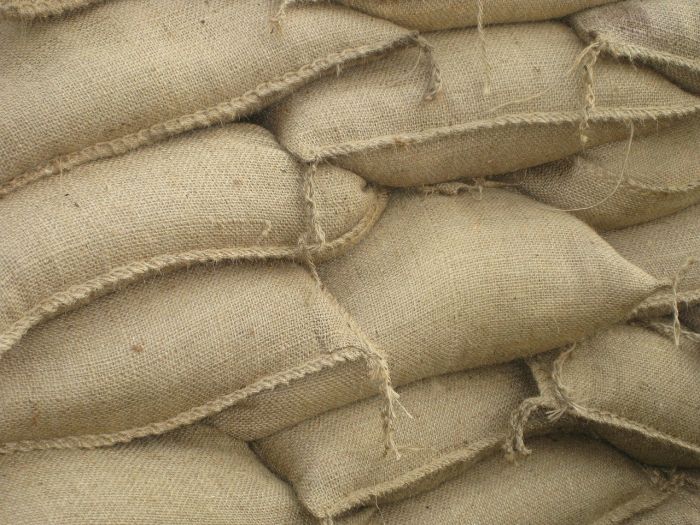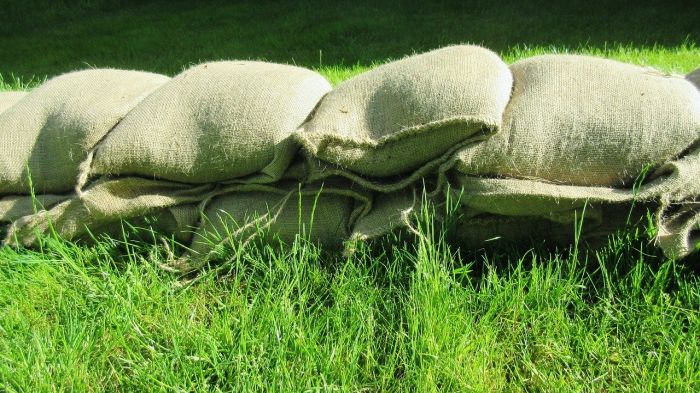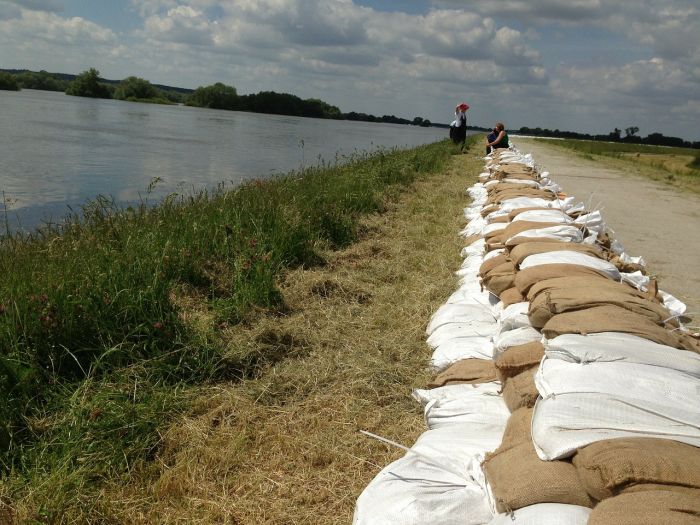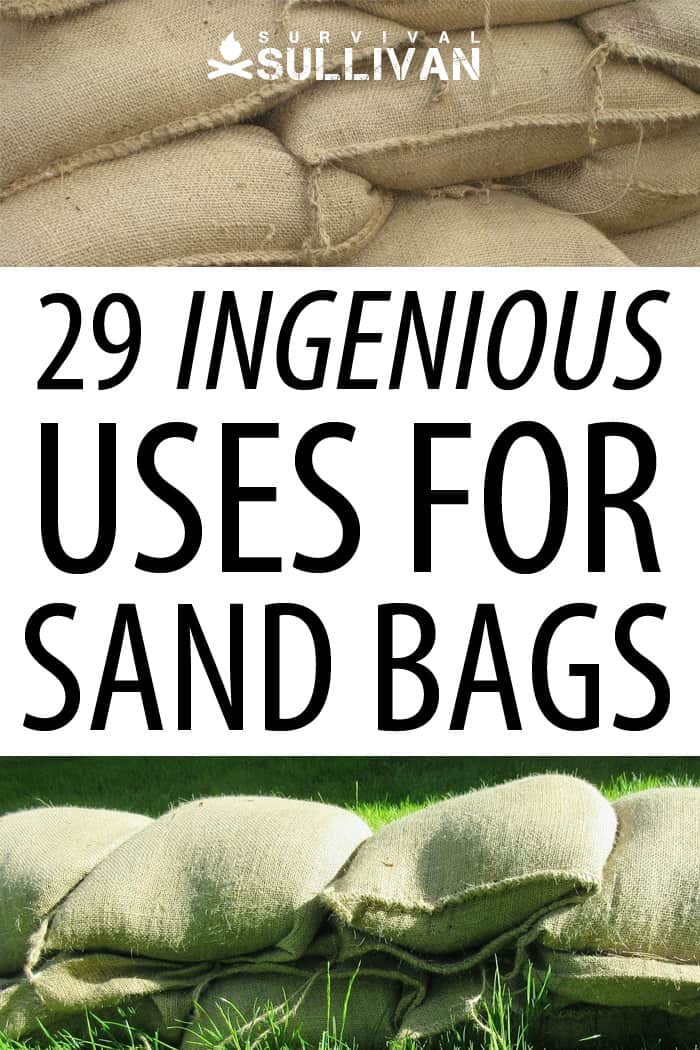29 Ingenious Uses for Sand Bags
Posted by admin on
Sandbags should part of your survival stockpile, even if you live nowhere near a flood zone. These durable items have a multitude of uses, perhaps not as many as duct tape, but it would at least be a decent contest.
You can use sandbags not just to hold back water, but as a ballistic barrier against armed marauders, to create an emergency shelter for people or livestock, and as a windbreak just to name a few.

Sandbags are lightweight, and take up little space when they are empty. If you live on a homestead, or if you have domestic pets, you can upcycle their feed sacks into homemade sand bags as well.
Sand Bag FAQ
- A filled sand bag typically weighs about 40 pounds.
- Sand bags measure approximately 14 inches wide by 26 inches long.
- Sand bags are typically made out of polypropylene or burlap.
- They generally last between eight months to one year when continually exposed to the elements particularly the summer sun and water.
- Sand bags can be filled with not just sand, but with dirt, gravel, and even a concrete mixture for use with different types of DIY projects.
29 Ways to Use Sandbags in and Around Your Home
1. To Build and Emergency Shelter
Sand bags can be used to build a floor or sides for an emergency shelter. You can pound some stakes into the four corners next to the sandbags extending up to a desired roof height. Once the stakes are in place, you can tie a tarp across the top to make a roof.
If the shelter is going to be used for more than a temporary shelter, a sturdy wood roof can be built over the sandbag walls. Whether or not you can place sandbags on the roof to further protect the shelter will depend on how sturdily the roof was constructed, and on how heavily you fill them.
A shelter like this one could be used as an LP/OP (listening post / observation post), covert bunker-style shelter established near a buried cache, or visible sentry post on your prepper retreat.
If you keep a tent in your pickup truck or SUV, consider packing some sand bags. They can be stored in a truck, or with a little folding shovel empty inside of an SUV.
They could be filled and placed around the sides of the tent for extra protection for inclement weather, predators, and high wind that can cause tent sides to collapse.
When constructing a structure that is going to be used fairly long-term, there are steps you can take to make it more durable. You can mix 1 part cement with 10 parts of either dirt of soil (if using polypropylene sand bags).
If using burlap sand bags, place only the dry ingredients inside then lightly spray with water through the burlap after the bag has been placed in its intended spot. You can also baste the top of the burlap bags with a cement mix to better protect them from rotting.
2. To Assist With Vehicle Traction
Sand bags can be filled just slightly, and placed under tires to give them traction when stuck in the mud. Remember to tie the sand bag tightly together to avoid it moving too easily and getting tangled up around the tire instead of helping ease it out of a muddy situation.
3. To Prevent Soil Erosion
Curtail soil erosion along creek beds, and steep hillside with a lot of water runoff by using sand bags. Use sandbags to set up a retaining wall. Fill the sand bags full, and tie them tightly before putting them into place.
To deter soil erosion, stack the filled sand bags tightly in front of the creek, stream or river bank that is starting to slip, is slipping, or experiencing a lot of runoff and causing mudslide concerns.
The sand bags can be placed directly into the water; they will not float away. Stack the bags on top of each-other tightly to build as solid of a wall as possible. The sandbag wall must be at least as tall as the waterway bed or peak of slippage area.
Being stuck in a mud bog with armed marauders on your tail is not a spot you would ever want to be in. Doing something as simple as keeping sandbags in your vehicle could perhaps help save your life.
4. As Gardening Containers
Fill a sandbag with quality compost, and lay it down flat on a broadside. Use a sharp knife to cut the middle of the broad side open, staying at least two fingers width away from the side panels.
Use the sandbags as gardening containers to start seeds of all types, to grow most types of herbs, garlic, onions, lettuce, carrots, and similar vegetables that do not need deep pots of soil to grow and mature.
These makeshift plant containers will also be portable, allowing you to take your growing food with you during a bugout. For more unconventional container ideas, check out this other article.
5. To Build a Retaining Wall
Build a retaining wall on your property to prevent potential slippage, to use as a vertical growing area, to use as a privacy fence, or to establish a physical barrier that would be difficult to penetrate by predators or by attackers.
Sand bags make an excellent physical barrier around a ground plot garden to keep rabbits and other 4-legged predators thieves out, and around poultry coops to prevent mink, raccoons, and similar predators away from your meat and egg birds.
In addition to being filled and used in a wall fashion to keep animals out of your garden, you can also cut sandbags apart and then duct tape or sew them together to make a sheet style wall that is tied or stapled to stakes to deter entry to the growing plot.
6. Off Grid Insulation
When building an off the grid home, barn, storage shed, or garage, sand bags can be used to help insulate the structure. Straw bales can be used inside of walls to provide insulation to structures in some environments, but they do not work as well in regions where dampness, humidity, and harsh winters are common.
To inexpensively insulate a structure that you are building, fill sandbags with dirt, and place them in between the interior and exterior walls. The dirt will prompt a geothermal response similar to what early pioneers who built dugout to live in or folks who construct earth berm homes.
You can use this same concept to help keep livestock warm during intense periods of cold and freezing temperatures. Fill the sandbags with dirt, and stack them at least two high around the perimeter of the barn, chicken coop, or pen enclosures to help keep the winter chill and wind from flowing so easily into the barn.
7. Ballistic Barrier
Sand bags can be filled thickly and stacked to help prevent ammunition from being fired through them. No, sand bags will not stop every type of round that can be fired at them, but they sure can stop some calibers, and hopefully limit the amount of destruction a higher caliber round seeks to wreak.
In the sand bags ballistic test shown in the video below, The Remington Magnum 7 mm, .223 caliber, 40 Smith and Wesson, 9mm, and 7.62X54R rounds fired at them did not get through. The rounds were filed from approximately 10 yards away from the filled sand bags.
The ammo curtailing nature of sandbags is also why making a wall out of them to serve as a backstop to a home ammo range works so well.
As noted by the sandbag penetration tester, for about $30 you can build a 10 X 10 protective wall.
8. Livestock Waterer Protection
Fill sandbags with dirt, and place them around (and if possible over) all livestock waterers during the winter months to help prevent the water from getting cold enough to freeze.
Floating several water bottles filled halfway with salt inside of the waterers will also help prevent the needed water from turning into a block of solid ice.

9. Traffic Blockade
Use sandbags to make a traffic barrier to prevent vehicles and ATVs from gaining access to your driveway, land, or street. If you are planning on bugging in, there is likely no cheaper way to prepare for such a survival situation than buying up sandbags in bulk, or making your own.
If you live in a small town or suburban neighborhood, blocking off entry to the block or blocks it covers and setting up a security patrol would vastly enhance the safety of your loved ones.
Even though all of your neighbors are not preppers now, I would find it hard to believe they wont follow your lead, and lend a hand setting up the sandbag blockade after the SHTF.
10. Emergency Tarp or Blanket
Sew or duct tape multiple sandbags together to make a tarp or emergency blanket or tarp to keep in your vehicle, bugout location, INCH bag, or get me home bag.
This multiple use supply will be lightweight to carry, take up little space when folded, and will dry quickly after becoming wet.
11. Water Gathering and Filtration
Fold a sand bag into a traditional bladder shape, and use it to carry water a short distance, or as a makeshift filter when attempting to screen debris from water when taking steps to make it potable.
12. Homemade Sack
The sandbag can be used as a durable pouch to carry wild game after hunting or tracking or to tote produce many other types of supplies.
13. As Kindling
An empty sand bag cut into strips can be used alone as kindling or slathered with petroleum jelly, turpentine, rubbing alcohol, etc. and used to help get a fire going. Get more tinder and kindling ideas here.
14. Fishing Line and Tripwire
Remove the string from the top of the sand bag and repurpose it as either a trip wire or as fishing line. The string is highly water-resistant and durable, making it capable enough to even handle the catching of a large bass.
15. Wild Game Trap
The bag itself can be turned into a trap for small wild game such as squirrels and raccoons.
16. Patching
Sand bags can be cut into squares or strips, and be used as patching on tents, tarps, for other sand bags that are already filled and in use, and on bugout bags.
17. Food Storage
Use washed, clean, and dry sand bags to store long-term foods such as wheat, rice, flour, and other grains.
18. Trail Markers Emergency Off Grid Communication
By cutting a sand bag into strips, it can be tied to a tree branch or other item and used to mark a path, label trails, or be written upon in code and used as a SHTF off grid communication marker.
19. Glass Protection
Stacking filled sandbags in front of your home and structure windows can protect the glass from a warfare blast and hurricane force winds.
20. Privacy Blind
Sewing or duct taping a sheet of attached sandbags around a curtain rod will create a privacy shield, but still allow light to enter the home or vehicle.
21. Emergency First Aid
Cutting a sand bag into long strips or a wide swatch allows the material to be used as a makeshift bandage, bandage cover, tourniquet, sling, or ice bag.
22. Bedding
A sand bag filled with dirt, leaves, sand, or any soft material could be used as a makeshift pillow or mattress in a survival situation, or so save money when setting up multiple living quarters at a prepper retreat.
When making a mattress, multiple sandbags will need to be cut apart, hand duct taped or sewn together in a quilt-like fashion to make them large enough to use as an adult mattress.
23. Weather Protection
A sand bag can be used to cover a bugout bag or boots to make them more water resistant, it can be cut apart and secured to more sand bags to make a poncho, or it can be duct taped around a tripod made out of branches to serve as an austere umbrella.
24. Seating
One or more sand bags can be attached with staples to a frame to serve as a chair or stool base.
25. Camo Gear
Spray paint sand bags in colors that match the seasonal terrain, and use them to cover your outerwear, bugout bag, hat and face, or use in greater quantity, and attached to cover your vehicle. Sandbags make an excellent base for a DIY ghillie suit.
26. Tactical Training
Make a knife dummy, archery target, or gun target out of filled sandbags to further your tactical survival skills training. Hanging a filled sandbag from a sturdy frame is a super cheap way to make a swinging target for advance practice.
27. Counter Weight
A sand bag can be filled with the desired amount of sand or dirt needed to serve as a counter weight when needed for a home repair project.
28. Water Diversion
When trenching or digging out a low lying area or edge of a road driveway that gets too muddy or slick when it rains or snows, use filled sand bags as a one or two bags high border around the digging to divert the water in the direction you want it to go instead of pooling in the low lying spot or running off onto the road.
Sewing sand bags together can be either done by hand or on most sewing machines. I used a doll makers or upholstery needle to sew sandbags or livestock feed bags together because it is long, and can be found in a hook or semi-hook shape. A durable string or fishing line is recommended for sewing together sandbags.

29. To Stop Flood Waters (Of Course)
Probably the most well-known alternative use for a sandbag. If you live in a flood area, sandbags should be on everyones inventory list, prepper or not.
Wrap-Up
At a cost of approximately $12 to $15 per case of 100, there are few cheaper preps by quantity than sandbags. When buying sandbags in bulk to store for future use, always store them in a cool, fairly dark, and dry place to avoid rotting especially if using burlap sand bags.

The post 29 Ingenious Uses for Sand Bags appeared first on Survival Sullivan.
